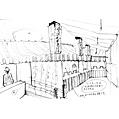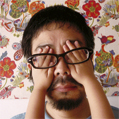小沢 剛 / OZAWA TSUYOSHI
展覧会概要

© Tsuyoshi Ozawa and Ota Fine Arts
小沢剛の作品を読み解くキーワードのひとつに「旅」あるいは「旅人の視点」というものがあります。今回の小沢剛のテーマもそのような視点から「金沢」を紐解いたものです。タウンガイドからインターネット上の情報、郷土史と様々な資料に目を通し、自ら街を歩き、人々と話しながら、金沢らしさを醸し出すものを選び出しています。選ばれたものは、金沢の人であれば誰でも知っているけれども、今は忘れていたり、気にかけないものであったりします。また有名な観光ガイドからは外れているけれど、ある意味では金沢らしいものであり、「歴史的な」と形容するには、あまりにささやかですが、知るとつい笑みが浮かぶようなユニークな過去をもつものです。それは、古くから残る民話、伝説であったり、それらを伝える遺物やもっと日常的な食べ物であったりします。鏡石、ハントンライス、弥七の豆殻太鼓、七つ橋巡り、飴買い幽霊、芋掘り籐五郎、天狗伝説、辰巳ダム。それらを金沢の七不思議として(実際は、それにひとつ加えて)作品にしています。展示場所は、明治40年に金沢貯蔵銀行として建設された美しい日本建築で、現在は石川県有形指定文化財に指定されている尾張町町民文化館です。[秋元雄史]
One of the key words to understand Ozawa's works is“journey” or “traveler's viewpoint.” This time, he looks at Kanazawa from that angle, selecting things that express Kanazawa’s essence while walking around the city and talking with local residents. This work consists of seven (with additional one) selected items as the Seven Wonders of Kanazawa. Every citizen of Kanazawa heard or knows of them, but now some are forgotten away or paid no attention to, such as folktales, relics, and everyday food. The venue is a town hall designated as a tangible cultural property in Ishikawa Prefecture that shows a beautiful Japanese architecture early in the Meiji period.
One of the key words to understand Ozawa's works is“journey” or “traveler's viewpoint.” This time, he looks at Kanazawa from that angle, selecting things that express Kanazawa’s essence while walking around the city and talking with local residents. This work consists of seven (with additional one) selected items as the Seven Wonders of Kanazawa. Every citizen of Kanazawa heard or knows of them, but now some are forgotten away or paid no attention to, such as folktales, relics, and everyday food. The venue is a town hall designated as a tangible cultural property in Ishikawa Prefecture that shows a beautiful Japanese architecture early in the Meiji period.
プロフィール

東京藝術大学在学中から、風景の中に自作の地蔵を建立する《ジゾーイング(地蔵建立)》 を開始。1993 年から牛乳箱を超小型移動式ギャラリーにした《なすび画廊》 や《相談芸術》 、1999年には香川に日本美術史への皮肉ともいえる《醤油画記念館》 を開館、また2007 年には豊島に不法投棄された産業廃棄物を材料に仏像を制作し、88 体を直島に設置した《スラグブッダ88》 など、多数ある。ユーモアを交えた作品スタイルは軽妙で、環境や平和などのメッセージが、自由な発想で作品化されている。
As a student of Tokyo National University of Fine Arts and Music, Ozawa started his project “Jizoing,” in which he installed a Jizo of his own making in different scenes. Since 1993, he has produced “Nasubi Gallery,” milk boxes used as extremely small transferable galleries, and “The University of Sodan Art”. His many other projects include “Soy-sauce Museum” in Kagawa Prefecture, which he opened in 1999 as a kind of irony to the Japanese art history, and “Slag Buddha 88” starting in 2007, for which he made images of Buddha using industrial waste dumped illegally on Teshima island and installed 88 Buddha images on Naoshima island. His humor-tinged work style is witty and refined, and his message concerning the environment, peace and so forth is expressed in his unfettered way of thinking of art.
As a student of Tokyo National University of Fine Arts and Music, Ozawa started his project “Jizoing,” in which he installed a Jizo of his own making in different scenes. Since 1993, he has produced “Nasubi Gallery,” milk boxes used as extremely small transferable galleries, and “The University of Sodan Art”. His many other projects include “Soy-sauce Museum” in Kagawa Prefecture, which he opened in 1999 as a kind of irony to the Japanese art history, and “Slag Buddha 88” starting in 2007, for which he made images of Buddha using industrial waste dumped illegally on Teshima island and installed 88 Buddha images on Naoshima island. His humor-tinged work style is witty and refined, and his message concerning the environment, peace and so forth is expressed in his unfettered way of thinking of art.